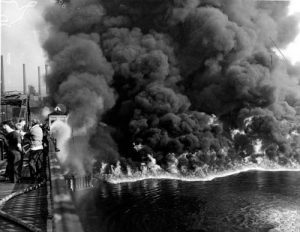5.0 Introduction
Learning Objectives
At the end of this chapter, learners will be able to:
- Describe positive and negative externalities
- Identify the economic impact of externalities
- Discuss the government policies to achieve efficiency in markets with externalities
- Explore coase theorem and private bargaining

In 1969, the Cuyahoga River in Ohio was so polluted that it spontaneously burst into flame. Air pollution was so bad at that time that Chattanooga, Tennessee was a city where, as an article from Sports Illustrated put it: “the death rate from tuberculosis was double that of the rest of Tennessee and triple that of the rest of the United States, a city in which the filth in the air was so bad it melted nylon stockings off women’s legs, in which executives kept supplies of clean white shirts in their offices so they could change when a shirt became too gray to be presentable, in which headlights were turned on at high noon because the sun was eclipsed by the gunk in the sky.”
The problem of pollution arises for every economy in the world, whether high-income or low-income, and whether market-oriented or command-oriented. Every country needs to strike some balance between production and environmental quality. This chapter begins by discussing how firms may fail to take certain social costs, like pollution, into their planning if they do not need to pay these costs. Traditionally, policies for environmental protection have focused on governmental limits on how much of each pollutant could be emitted. While this approach has had some success, economists have suggested a range of more flexible, market-oriented policies that reduce pollution at a lower cost.
Attribution
“Chapter 12 Environmental Protection and Negative Externalities” in Principles of Economics 2e by OpenStax is licensed under Creative Commons Attribution 4.0 International License.

